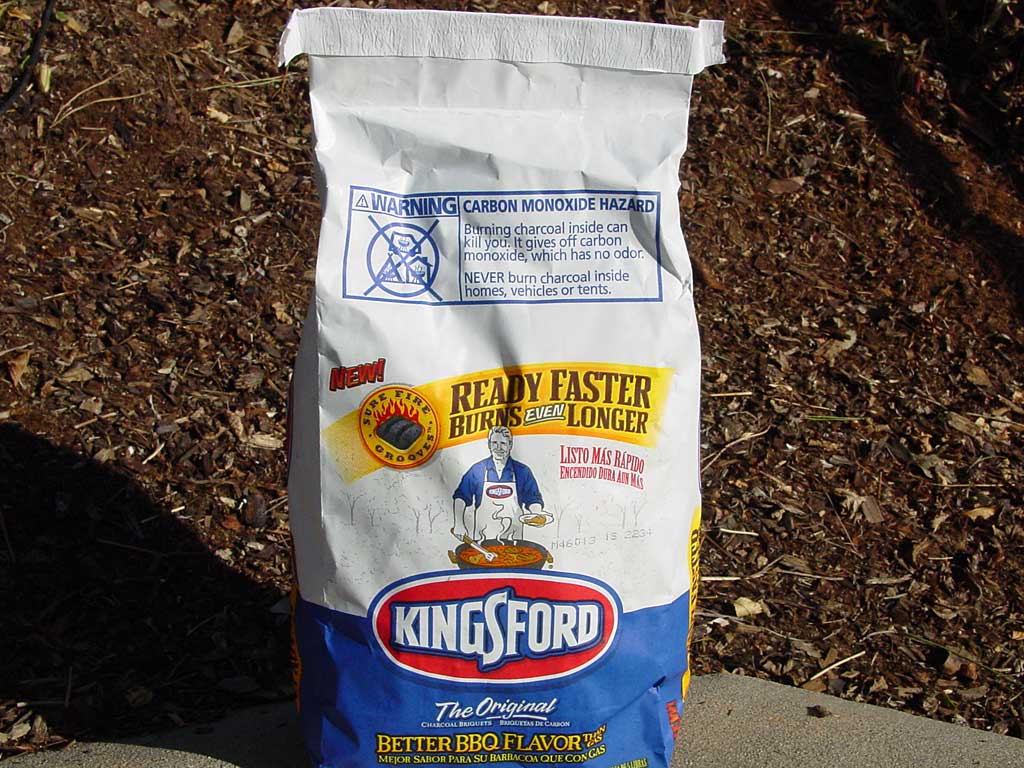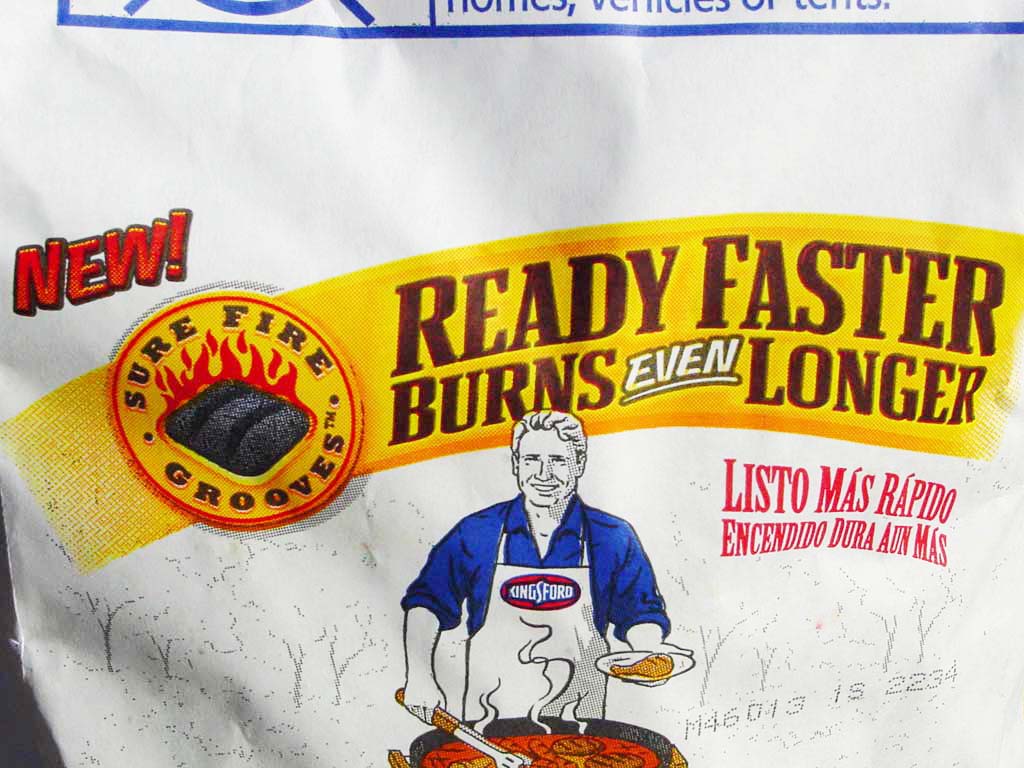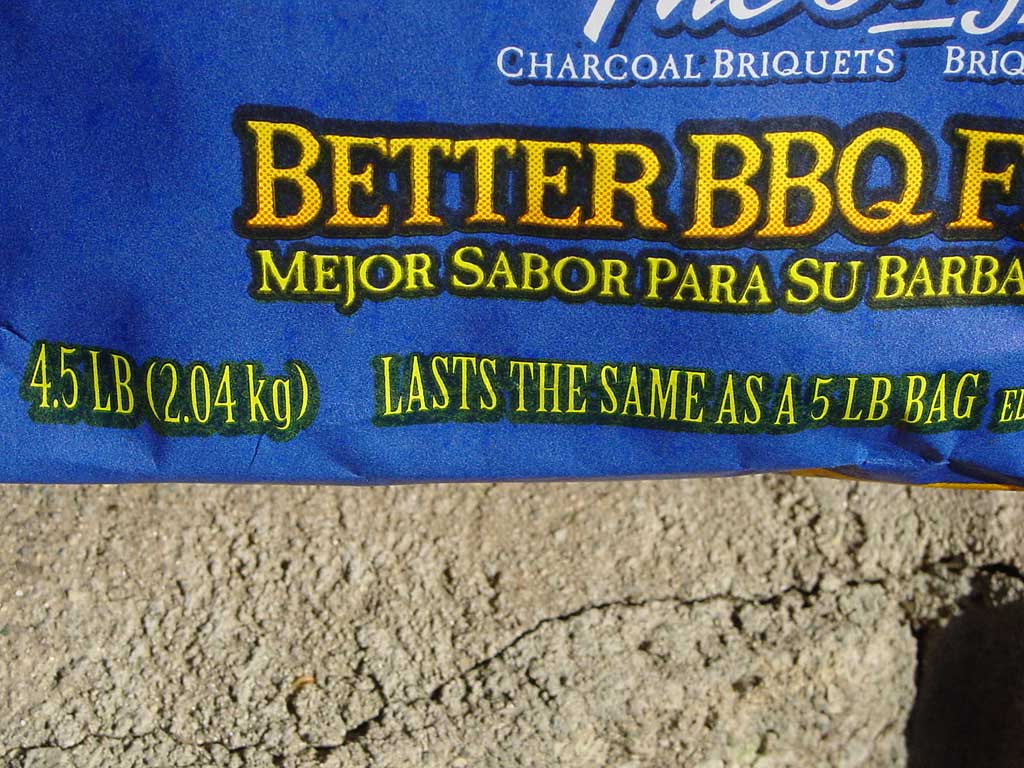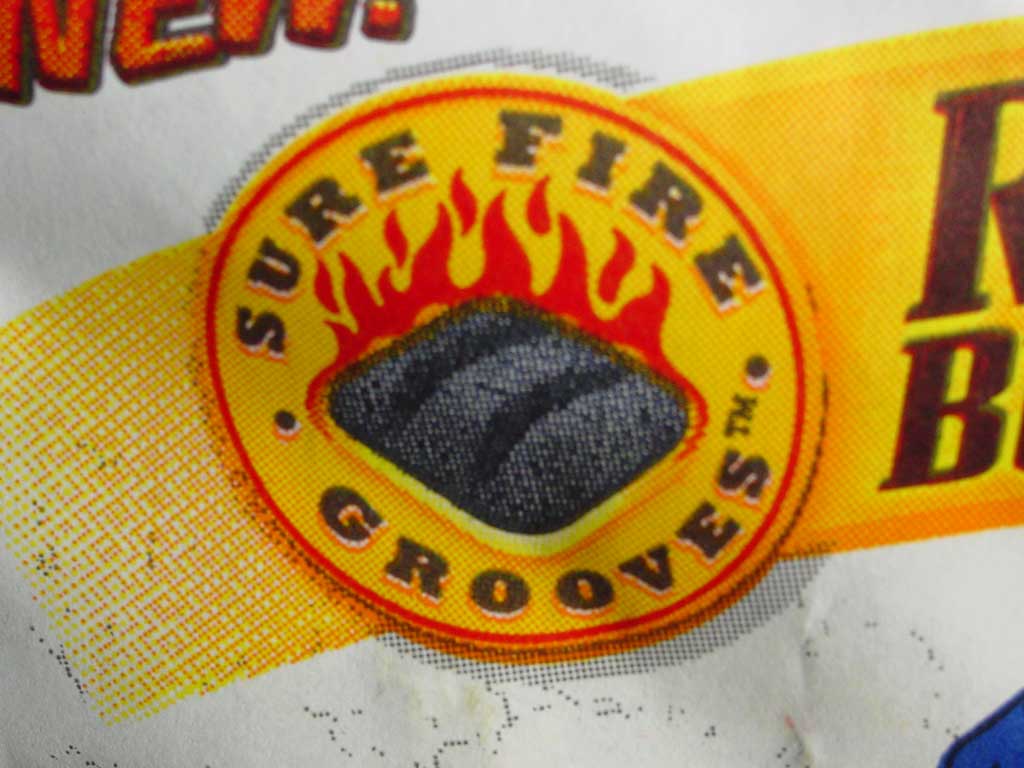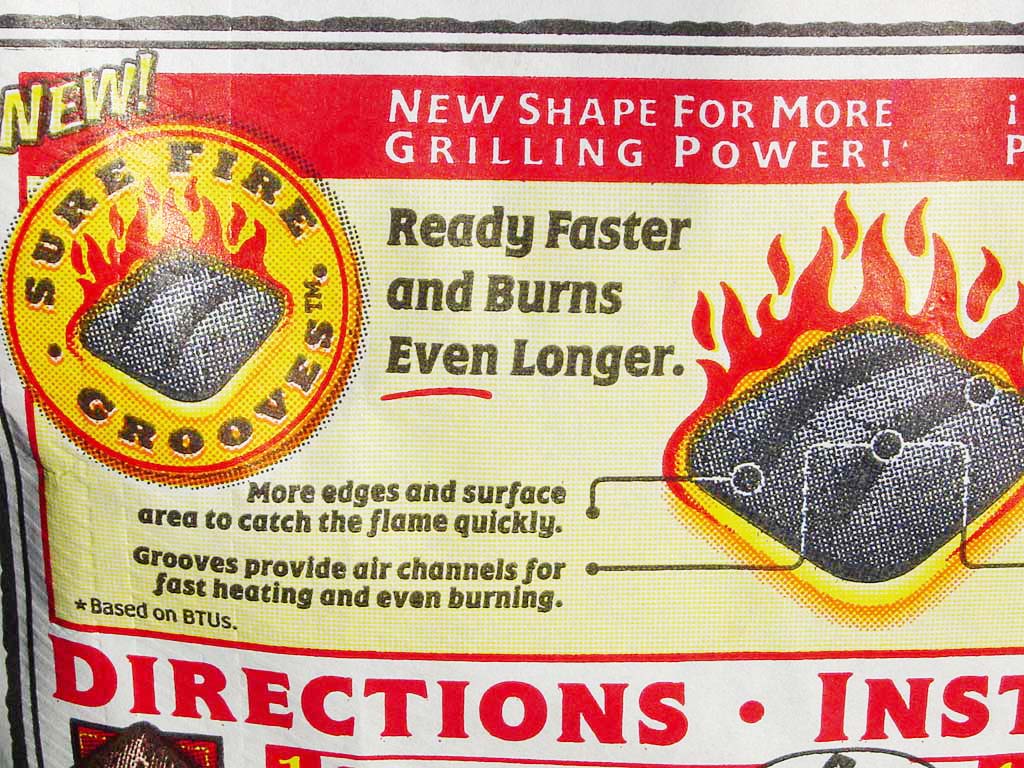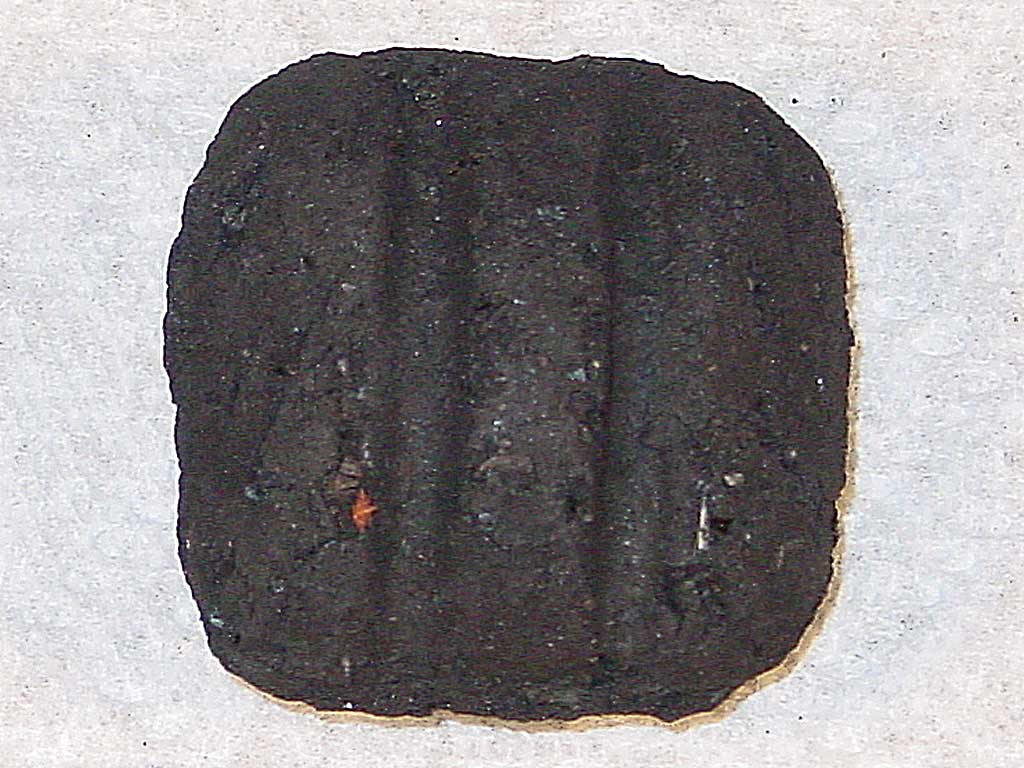In This Topic
- Introduction
- What Kingsford Says About The New Product
- Ready Faster, Burns Even Longer
- What Makes New Kingsford Different
- Why Kingsford Changed The Product
- How New Kingsford Works
- Briquettes Weigh Less; Bag & Number Of Uses Remain The Same
- Questions About New Kingsford
- More Kingsford Links On TVWB
Note: This article has been revised based on discussions with Kingsford R&D scientists during my visit to the Clorox Technical Center on April 9, 2006. See Kingsford R&D Lab Trip Report for more information.
The company has also produced a two-page fact sheet that explains the benefits of new Kingsford Charcoal Briquets and answers questions you may have about the product:
Introduction
The Clorox Company, makers of Kingsford Charcoal Briquets, has changed the design and formula of its line of charcoal products for 2006. These changes apply to all Kingsford products, including the regular “blue bag” briquettes, Kingsford Charcoal Briquets with Mesquite, and Match Light Instant Light Briquets.
The Virtual Weber Bulletin Board has been abuzz with discussion about this new product since the end of 2005, as Kingsford has been a favorite of many Weber Smokey Mountain Cooker owners over the years.
One concern is that it is all marketing hype and just a way for Kingsford to keep charging the same amount of money for less product in the bag.
Another concern is that the new product does not perform as well for “low and slow” barbecuing using the Minion Method. At the time of this writing, bulletin board members offer conflicting reports on product performance in general. Some say it doesn’t last as long, others say it lasts just as long. Some say it produces less ash than before, others say it produces more ash. Some say it smells better than before, others don’t notice a difference.
While there certainly are differences between the old and new products, it’s hard to say how much real change people are noticing versus the fact that now people are paying much more attention to the performance of new Kingsford, and perhaps they’re noticing some variations that were always there, even with the old product.
In the end, what matters most is the cooking experience you have in your own backyard. As more people try the new Kingsford and report the results on The Virtual Weber Bulletin Board, we should begin to arrive at a consensus about the performance of the product for “low and slow” barbecue.
What Kingsford Says About The New Product
The company makes the following statements about “blue bag” Kingsford Charcoal Briquets with Sure Fire Grooves:
- Easier lighting
- Ready faster
- Ready to cook your food in about 15 minutes
- Burns even longer
- Burns slightly hotter
- New shape for more grilling power
- Formula enhancements and high quality ingredients contribute to longer burn time
- Weight of each briquette is less than before
- Bags are the same physical size as before
- Bags contain the same number of briquettes as before
- Bags provide the same number of uses as before
Ready Faster, Burns Even Longer
The phrase “ready faster, burns even longer” summarizes the value proposition of the new Kingsford.
The idea is that the new charcoal lights faster, so it’s ready to cook on sooner compared to the old product. Also, because it lights more efficiently, you burn less fuel bringing the grill up to cooking temperature, so you end up with more usable cooking time overall.
According to a press release, Kingsford makes the following claims:
- 38% improvement in lighting time
- 22% improvement in the time it takes to get ready for cooking
- 13% increase in cooking time at a temperature over 380°F
Remember that these claims are based on testing in the R&D lab. Your mileage will vary depending on an infinite number of variables in your own backyard.
What Makes New Kingsford Different
The obvious visual difference with these new briquettes is something Kingsford calls Sure Fire Grooves. Two parallel grooves are pressed into the back of each briquette during the manufacturing process. Given the briquette’s pillow shape, the grooves are very shallow at the edges and about 1/8″ deep at the center of the briquette.
When the manufacturing process is working perfectly, both old and new briquettes have the same dimensions.
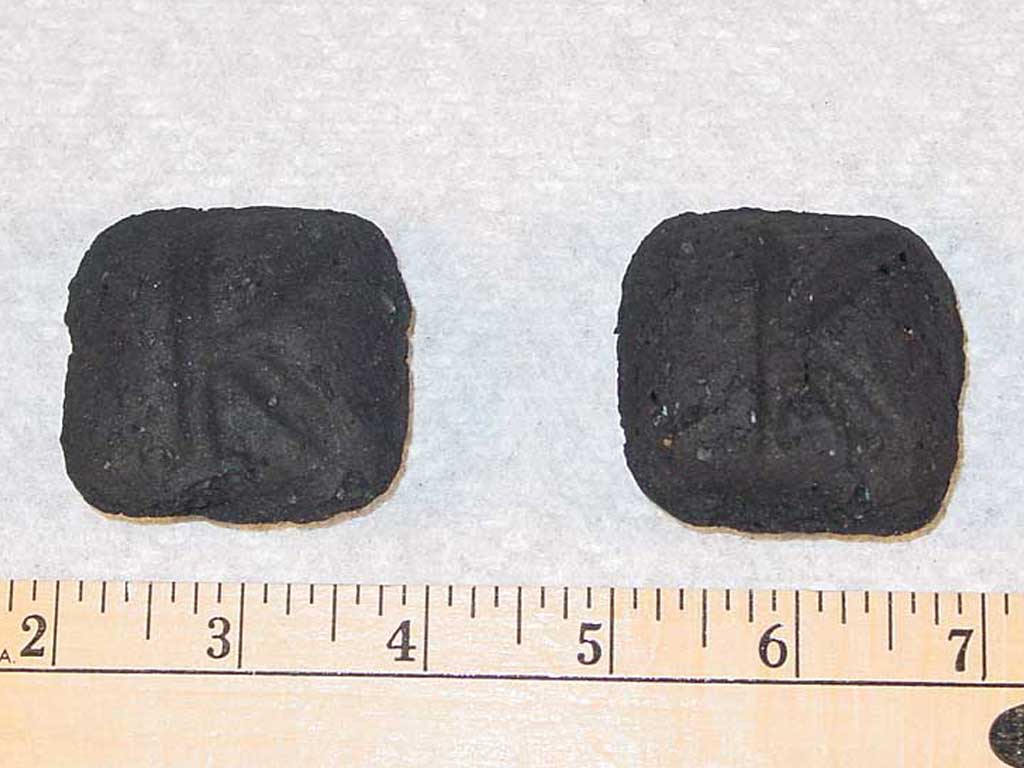
Old Kingsford (left), new Kingsford (right). The new product still features the “K” imprint on the front.
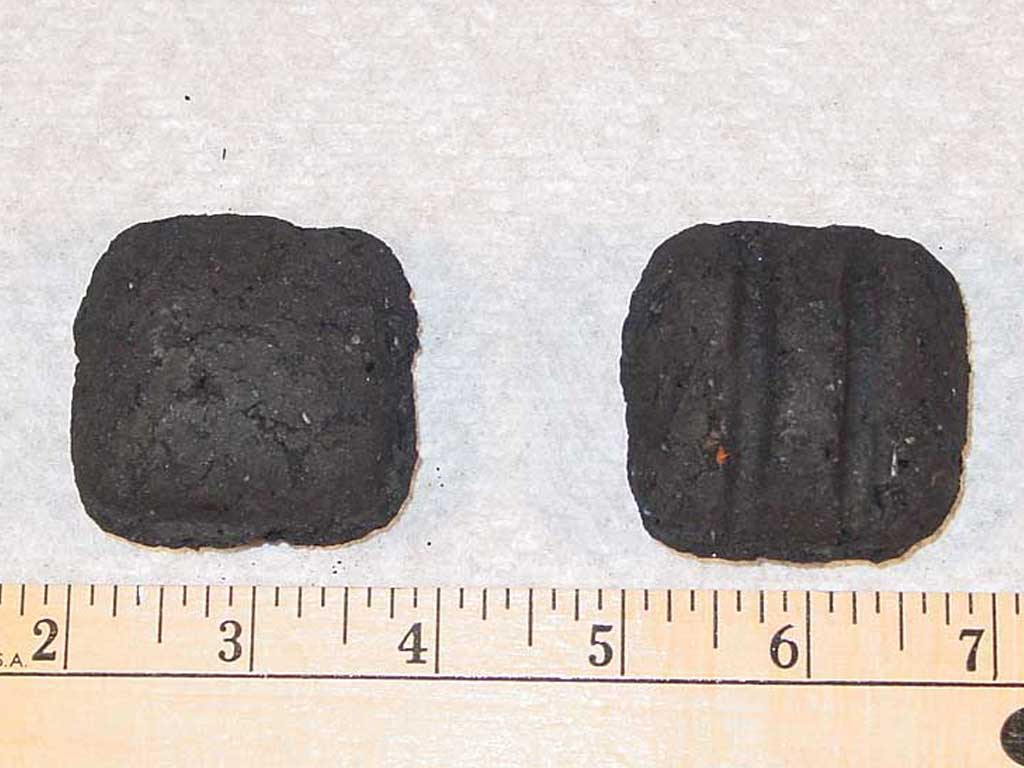
The old product (left) is smooth on the back, while the new product (right) has “Sure Fire Grooves”.
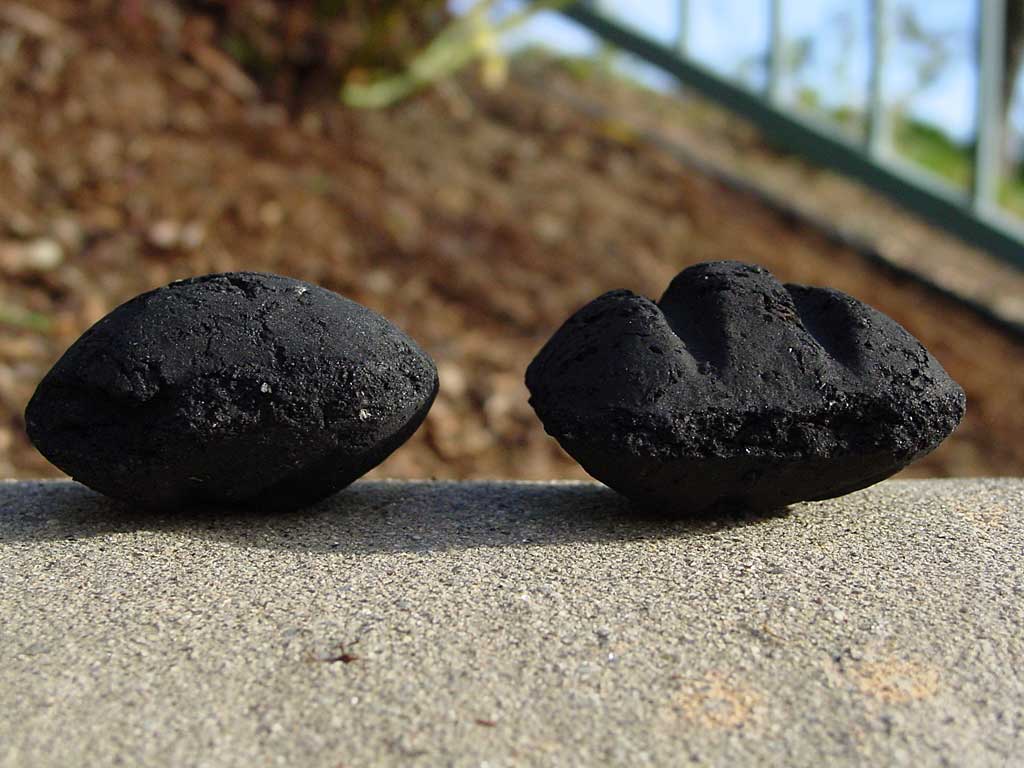
The old product (left) and new product (right) should have the same dimensions when manufactured correctly, but some variation will occur from batch to batch.
Another difference is that the product formula has changed. At the time of writing, Kingsford will not divulge the ingredient list for the new product.
During my visit to the Kingsford R&D lab in April 2006, Bob Miller, the Kingsford R&D manager, acknowledged that wood char is the most abundant ingredient in the new product and that more wood char is being used in the new product than before. He said this change has resulted in better product performance and a higher manufacturing cost. He also said that when burned in equal volumes, the new product should produce about 10% less ash because it weighs 10% less than the old product and because it contains more wood char.
To see the ingredient list for the old Kingsford product and the purpose of each one, read the All About Charcoal article. It will give you a good idea of what’s probably in the new product.
Why Kingsford Changed The Product
Even though the company knew that Kingsford was the market leader and felt it performed better than competitive products (according to their own lab testing), they believed the product could be improved to light faster, be ready to cook on sooner, and burn longer than the old product.
Company management understood that Kingsford is an American icon, so the decision to undertake a new product design and formula was not taken lightly. The R&D staff had to prove to management through lab testing and consumer testing that the new product performed better than the old one.
Although not stated by the company, it is my opinion that the new product is intended to help Kingsford charcoal compete more effectively against the convenience of gas grills. As such, the product changes are primarily designed to help people who grill at high temperature, not those of us who cook “low and slow”.
How New Kingsford Works
Kingsford experimented with a variety of briquette sizes and shapes to create a faster lighting briquette. In the R&D lab I saw several prototype press rolls, some that made great big briquettes, some that made very small ones, and some that made different shaped impressions in a briquette. Lab testing showed that some designs worked while others did not.
Ultimately, the old briquette size and shape with the addition of two parallel grooves in one side was chosen. These grooves create more surface area on the briquette, more edges where the briquette can catch fire, and more air circulation between briquettes.
Prototype grooved briquettes using the old product formula were sent to a number of consumers for field testing. Consumers reported that the prototype certainly lit faster, but they did not discern any difference in burn time, even though the addition of grooves resulted in a slight increase in burn time that could be measured in the test lab.
So Kingsford began working on different product formulas, ultimately deciding to add more “high quality ingredients”, most notably wood char, to give the new product a longer burn time that was both measurable in the test lab and noticeable to consumers.
Briquettes Weigh Less; Bag & Number Of Uses Remain The Same
New Kingsford weighs 10% less than before. The loss of material due to the Sure Fire Groove impressions is one reason. Another reason is that more wood char is being used in the product, which is a very lightweight ingredient.
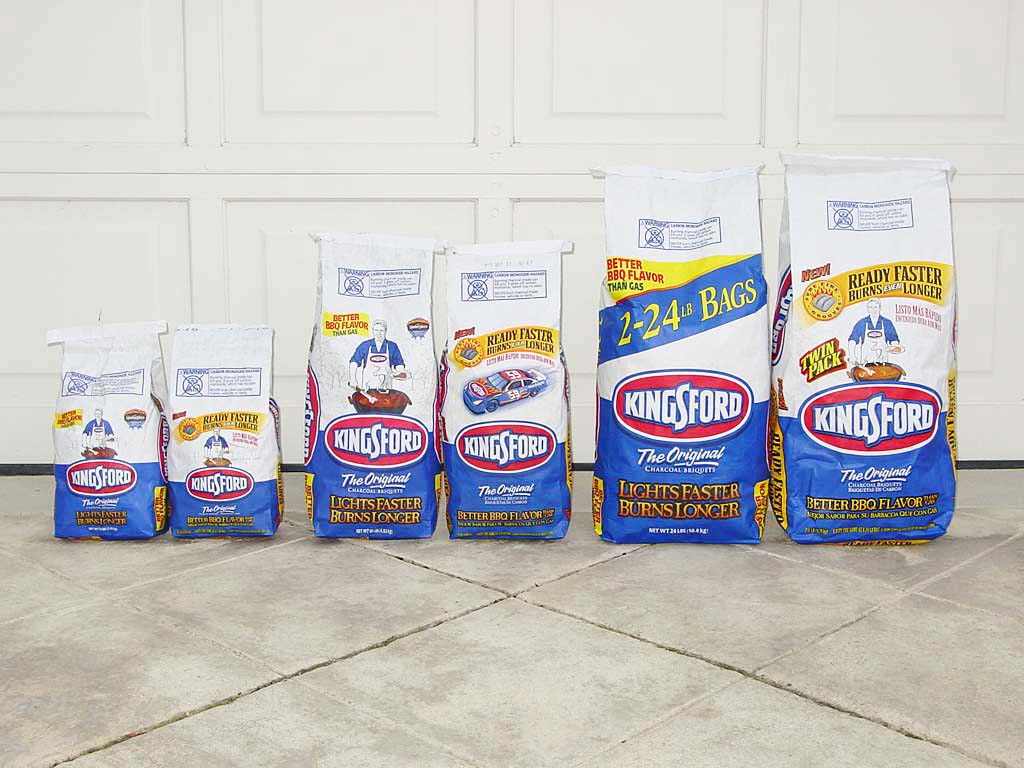
Old and new bags of Kingsford are the same physical size. From left to right: 5lb and 4.5lb, 10lb and 9lb, and 24lb and 21.6lb.
At the time of writing, the number of briquettes per bag, the number of uses per bag, the bag dimensions, and the price remain the same as before. However, each new bag weighs 10% less than the corresponding old one:
| Old Bag | New Bag |
| 5 lbs | 4.5 lbs |
| 10 lbs | 9 lbs |
| 20 lbs | 18 lbs |
| 24 lb twin-pack | 21.6 lb twin-pack |
Questions About New Kingsford
Q: When grilling or barbecuing, should I use more new Kingsford than I did old Kingsford?
A: No. The product is used by volume, not be weight. You should use the same volume as before.
If you grilled using a full Weber chimney starter of the old product, use a full Weber chimney of the new product. When cooking overnight in the WSM, if you filled the charcoal chamber to the top, do the same using the new product.
Q: I’ve heard that the new Kingsford doesn’t last as long for “low and slow” cooking using the Minion Method. Is this true?
A: At the time of writing, the jury is still out on this question—there are conflicting reports from people who have used the new product.
Kingsford offers the following suggestions for using the new product in the WSM with the Minion Method:
- Start with fewer hot coals to begin with. For example, if you normally start 20 briquettes of the old Kingsford, try using only 10 or 15 of the new product.
- These 10-15 briquettes will light faster than the old ones, so watch them carefully and place them on the unlit charcoal sooner than with the old product.
- Close the bottom dampers more than you would have with the old Kingsford, and do so earlier in the process to keep the temperature under control.
Q: Does new Kingsford produce less ash?
A: It should produce about 10% less ash because it weighs 10% less than old Kingsford due to Sure Fire Grooves, and because the new product formula contains more wood char, which produces very little ash.
Ash production may also vary from bag to bag based on manufacturing variations.
Q: Does new Kingsford contain lighter fluid?
A: No. It still requires the use of a chimney starter, lighter fluid, or other fire starter.
Q: Since new Kingsford weighs less but sells for the same price, isn’t that a stealth price increase?
A: That’s what some people think. My personal view is that the new product is meant to provide improved performance for the majority of Kingsford users—those who grill at high temperature. If the product does what it says it will do—lights faster, is ready to cook on sooner, and offers slightly longer usable cooking time—and the number of uses per bag and the price remain the same, then I don’t think it’s accurate to characterize the situation as a stealth price increase.
Q: Since the new bag weighs less, doesn’t it contain fewer briquettes and offer fewer uses per bag?
A: No. Even though it weighs less, each new bag is the same physical size, contains approximately the same number of briquettes, and offers the same number of uses as before.
Q: If you counted the number of briquettes in an old 24 pound bag and a new 21.6 pound bag, would you find exactly the same number of briquettes in each bag?
A: In a perfect world with perfect briquettes, 24 pounds of old product should be the same number of briquettes as 21.6 pounds of new product. However, it’s unlikely this would be the case if you compared two random bags of old and new product. It would also be unlikely if you compared two old 24 pound bags to one another or two new 21.6 pound bags to one another.
Bags are filled by weight, not volume. The contents of each bag should weigh the same or more than the net weight printed on the bag, but the number of briquettes may vary because:
- Individual briquettes can weigh more or less from one batch to the next. See the next question for a detailed explanation.
- The automated equipment that fills bags by weight may drop a few more briquettes into some bags than others.
- Some bags may accidentally get filled with more broken bits and pieces and fewer whole briquettes.
- Mishandling between the factory and the store may cause more broken bits and pieces and fewer whole briquettes.
Having said all that, if you were to sample a large quantity of bags, say 100 or 1000, and average the results, you should find approximately the same number of briquettes in both types of bags.
Q: Some sources on the Web say that the old and new products weigh the same, which contradicts what Kingsford says. Is this true?
A: There are variations in the manufacturing process from day to day and factory to factory that result in briquettes weighing more or less. This occurred with the old product, and it will continue to occur with the new product.
The press rolls that create the new briquettes are exactly the same size and shape as the old ones, except for the Sure Fire Grooves in one side. In theory, old and new briquettes should have the exact same dimensions, but the new ones weigh 10% less because of the grooves and the use of more wood char in the mix.
Sometimes briquettes come out slightly thinner than regulation because of worn press rolls. A more interesting situation occurs when the flow of mix into the briquette press varies.
The factory uses a volumetric feeder that continuously pushes a fixed amount of mix per minute into the rotating press rolls. When everything is working properly, the material flows into the press rolls at just the right rate and each briquette pops out with just the right weight, minus any broken corners, nicks and chips, etc.
However, if the flow rate is increased or decreased, the same number of briquettes pop out of the press rolls, but each one contains more or less material and therefore weighs more or less. In fact, it’s possible to get briquettes that appear to have the right dimensions, but actually weigh more than regulation.
So, back to the original question…
You compare the weight of old and new briquettes and find that the new ones weigh the same as the old ones. Given the manufacturing variations described above, do you have new briquettes that weigh too much, or old briquettes that weigh too little, or maybe a little of both?
The bottom line is that manufacturing variations make it difficult to compare the weight of briquettes from one bag to another in any meaningful way—old to old, new to new, or old to new.
If you were to sample a large quantity of bags, say 100 or 1000, and average the results, you should find that the new briquettes weigh 10% less than the old ones due to the grooves and the use of more wood char in the mix.
Q: Some sources on the Web say that both old and new products have essentially the same heat content. Is this true?
A: It’s hard to support that statement without conducting scientific testing. Kingsford does not measure charcoal based on heat content (e.g. BTUs) but on the factors described in my Kingsford R&D lab trip report.
Q: Will Kingsford change bag weights at some point in the future?
A: The warehouse twin-pack now weighs 21.6 pounds per bag, which is a very odd number. Maybe someday the company will transition to physically larger bags holding the old weights of 5, 10, 20, and 24 pounds, but this is pure speculation.
In some stores, Kingsford is now selling a new two 15-pound bag twin-pack that reads “Lasts the same as 16.7 LB bag”. Kingsford never sold a 16.7 pound bag of the old product, so this proves Kingsford is willing to produce a new bag size that weighs a nice, round number.
Q: Does Kingsford still make the old formula product?
More Kingsford Links On TVWB
- Burn Test 2022: Kingsford Original vs Franklin Barbecue vs B&B Competition Oak Charcoal Briquets
- Burn Test: 1984 Kingsford vs 2020 Kingsford
- Kingsford Long-Burning Charcoal Briquets & Weber 100% All Natural Hardwood Charcoal Briquettes Burn Test 2017
- Kingsford Professional Briquets Replace Competition Briquets
- New Kingsford Original Charcoal Briquets Formula For 2015
- Kingsford Charcoal Briquets – Minor Changes For 2010
- Kingsford Competition Briquets – New For 2009
- Kingsford R&D Lab Trip Report
- All About Charcoal

